How To Find Virus In Pc
A lot of mod malware, like spyware and cryptominers, is hard to discover, and thus difficult to remove. Just you'll want to consider how to get rid of a virus if y'all're experiencing:
-
A very ho-hum computer
-
Popular-up messages that appear out of nowhere and are hard to remove
-
Unrecognized computer programs launching on their own
-
The sound of the difficult drive in constant activeness
Whatever one of these symptoms might be caused by a virus or a unlike kind of malware. If you lot're experiencing two or iii of them at the aforementioned time, that's a strong indication that you've got a virus. That said, a lot of modern malware, similar spyware and cryptominers, go out of their style to stay as hidden as possible.
To go rid of a virus or malware, you'll need to download an antivirus programme. You lot can download AVG AntiVirus Gratuitous right now and accept it running in just a few minutes. It comes packed with scanners and a suite of other features for finding and expelling viruses and malware, even if your computer isn't exhibiting any symptoms.
If your Windows PC or laptop does have a virus, take the post-obit actions. (You'll notice Mac info at the bottom of the page. And if your telephone has been acting strangely, check out our guide to acquire how to know if your telephone has a virus or other form of malware.)
#one Remove the virus
These steps should work no matter what kind of malware you take on your PC. This procedure is as effective for Trojans or adware as it is for a run-of-the-mill virus.
Step one: Enter Safe Style
-
Hold the Shift key, then restart your computer by opening the Windows menu, clicking the power icon, and clicking Restart.
-
Your estimator will restart and brandish a card with several avant-garde boot options. Choose Troubleshoot.
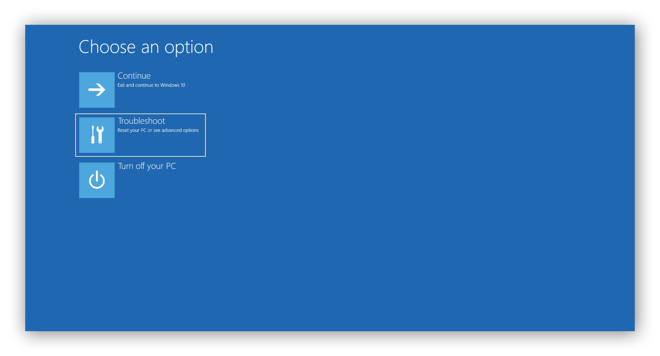
-
Choose Advanced Options.
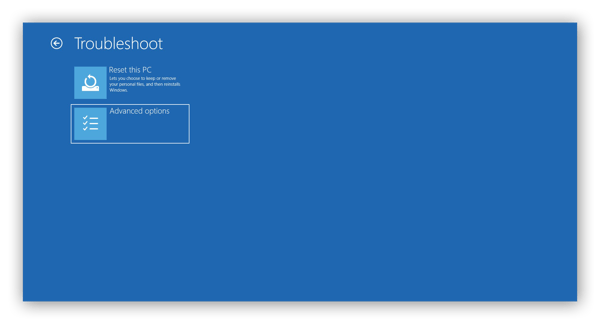
-
Click Startup Settings .
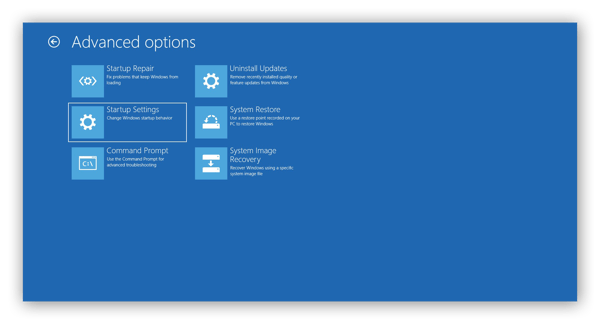
-
Click Restart.

-
Press 5 to restart in Condom Mode with Networking, only keep your PC disconnected from the internet.
Footstep 2: Delete temporary files
While y'all're in Safe Mode, delete your temporary files using the Disk Cleanup tool:
-
Become to the Start card and scroll down to Windows Administrative Tools. Click information technology and cull Deejay Cleanup from the drib-downwardly carte du jour.
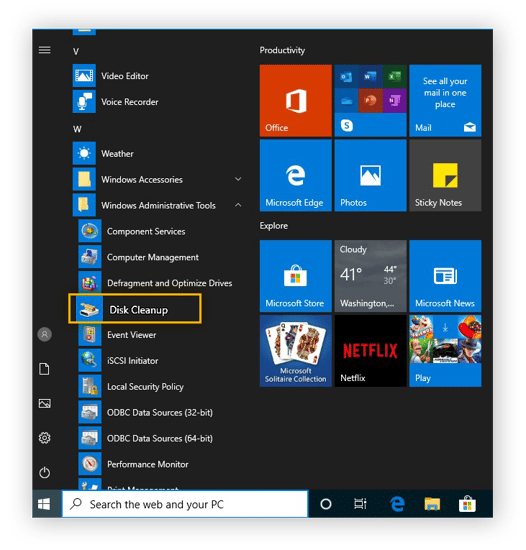
-
Scroll through the "Files to delete" list, and choose Temporary files. Click OK.
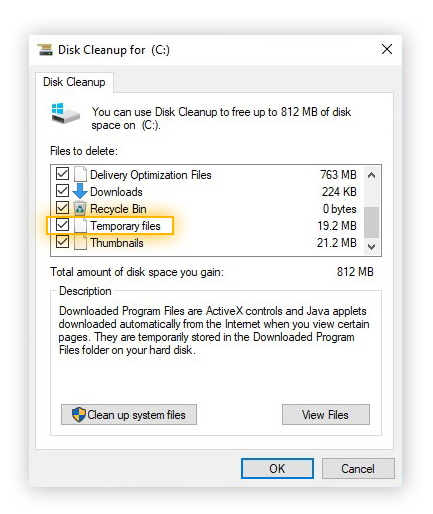 Deleting these files might speed up the virus scanning you're about to do. Deleting your temporary files may even get rid of your malware if information technology was programmed to start when your computer boots up.
Deleting these files might speed up the virus scanning you're about to do. Deleting your temporary files may even get rid of your malware if information technology was programmed to start when your computer boots up.
Step 3: Download a Virus Scanner
There are two types of scanners that tin can detect and remove computer viruses and malware: real-time and on-demand.
-
A existent-time scanner similar AVG AntiVirus Gratuitous scans for viruses in the background while yous're using your computer.
-
An on-need operating system scanner such as Microsoft Condom Scanner must be activated manually each fourth dimension you want to scan.
Using both types of scanner might be necessary to remove the virus. If you don't have a virus scanner installed, this is the time to reconnect to the net and download i.
Even if yous can't connect to the internet, you lot might still be able to download Microsoft Safe Scanner because you lot started upwards your computer in Condom Mode with Networking.
Step iv: Run a Virus Scan
Run the on-need scanner first, and then your real-time scanner. 1 of them alone should be able to identify and remove the virus, but running both scanners increases your odds of success.
If need be, remove a virus manually
Some malware must be removed manually. You should endeavour this just if you are experienced with using the Windows Registry and know how to find and delete bloatware and other junk files like arrangement and program files. If you lot're not sure, contact an Information technology skillful who should be able to aid show y'all how to remove viruses.
#2 Recover or reinstall whatsoever damaged files or software
Assuming the scan detected and removed the virus, you might need to reinstall any files or programs that were damaged.
This is where backups come in handy, and we strongly recommend y'all make them regularly, at least once a calendar week. That makes it piece of cake to restore deleted files on Windows and Mac devices. For optimal results, make sure to go an external difficult drive.
#iii Better your defenses
Keep your antivirus protection upwardly to engagement
Update your antivirus software to assist protect your laptop or PC against all types of malware. Information technology's critical to keep your cybersecurity tool current, because new viruses are beingness created all the fourth dimension. Even if you bought your antivirus a month ago, it might need updating now. Check out AVG's antivirus solutions — they install quickly and update automatically for effortless protection.
Make backups
Make regular backups of your files and store them on an external hard bulldoze, with a cloud service, or both. This can help prevent the loss of important information should you get some other malware infection. If y'all haven't been making backups, at present is a good time to get-go.
#4 Take proactive steps to preclude another infection
Here are some quick and easy things you can do to avoid downloading more malware again:
![]() Install the latest software updates for Windows.
Install the latest software updates for Windows.
![]()
Install an antivirus plan.
![]() Back up your data regularly.
Back up your data regularly.
![]() Avoid clicking on popular-upwards messages that claim to take detected a problem with your estimator.
Avoid clicking on popular-upwards messages that claim to take detected a problem with your estimator.
![]() Exist wary of opening emails from addresses you don't recognize, especially if they contain a link or an zipper.
Exist wary of opening emails from addresses you don't recognize, especially if they contain a link or an zipper.
A strong antivirus is your best defense in the fight confronting online threats. AVG AntiVirus Gratuitous is a powerful and reliable virus and malware removal tool. It comes loaded with congenital-in features to block dangerous downloads and malicious websites. And with round-the-clock software monitoring, yous'll exist prepared for whatsoever suspicious activity.
Getting rid of a virus or malware on a Mac
Many Mac users call back they can't get viruses, spyware, worms, or other malware. This isn't true, even though at that place are fewer viruses and malware targeting Macs than in that location are for Windows PCs and laptops. We've got an in-depth guide to Mac security, but we'll requite y'all a quick rundown here.
Some well-known examples of malware for Mac computers include:
-
MacDefender
-
MacProtector
-
MacSecurity
These names give the impression of being antivirus products, but they are all really malicious and designed to fool Mac users into submitting their credit menu or Apple ID business relationship details. Practice not download them.
The two main risks Mac users face are simulated alert messages and previously installed malware. If you lot see whatever kind of message while browsing the cyberspace along the lines of "a problem has been detected with your Mac," this is highly probable to be an try to become you lot to download malware. Instead, make the following tips function of your daily Mac habits.
-
Ignore the bulletin. If you did download anything from the site, quit Safari (or whichever browser you're using), go to the Downloads binder, and drag any items in there to the Trash. Then empty the Trash. Avoid visiting the website again considering it's possible that information technology has been hacked.
-
Quit the infected app. If you recall malware has already been installed on your Mac — especially if you're seeing popular-up messages asking for your Apple ID or credit carte du jour details — quit the app or shut down the software that you think might be infected. Open your Activity Monitor and locate the app in question, or search for the malware from the list of names higher up. When y'all've identified the malware, click the Quit Process button, then quit the Activity Monitor. And so become into your Applications folder and elevate the unwanted software into the Trash, and empty the Trash.
-
Finally, brand sure all your software and apps are up to date. Also make certain that your Mac is running the latest operating system and that y'all've installed any updates straight from Apple.
As with a PC, it is a good idea to equip your Mac with strong protection. AVG AntiVirus for Mac is a complimentary and comprehensive cybersecurity tool that detects and blocks malware, spyware, ransomware and other security risks in real time. And it's updated automatically to safeguard your Mac against the latest online threats.
Plus, AVG AntiVirus for Mac likewise helps you lot protect your family and friends, past detecting whatsoever PC or mobile threats hiding on your system and preventing you from accidentally infecting anyone else. Download AVG AntiVirus for Mac today — completely free.
Source: https://www.avg.com/en/signal/how-to-get-rid-of-a-virus-or-malware-on-your-computer
Posted by: gagnefloore45.blogspot.com


0 Response to "How To Find Virus In Pc"
Post a Comment